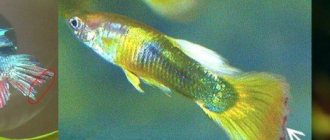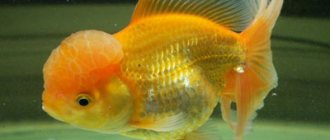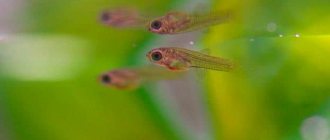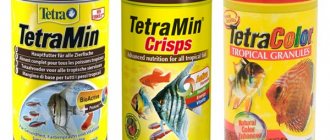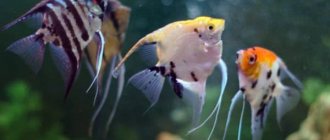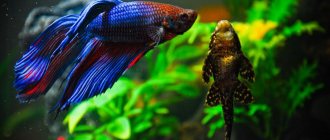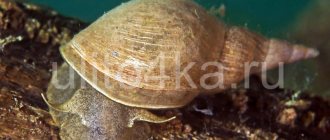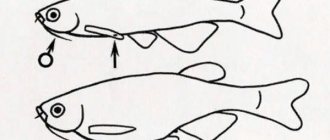4.9
(112)
When a person wants to start an aquarium, he, first of all, wants an underwater mini-world to appear at home, so that the fish will delight with their natural beauty. But, alas, modern decorative inhabitants are quite susceptible to all sorts of diseases. For example, every beginner or experienced aquarist is faced with such an unpleasant phenomenon as fin rot.
The initial stage of the disease with fin rot.
What is fin rot?
This is a fairly common disease that is bacterial in nature. It occurs due to infection by several types of bacteria, namely Pseudomonas, Aeromonas and Vibrio. The natural habitat of this infection is various bodies of water. In aquarium conditions, these bacteria do not grow on their own. Fish can only get sick if the owner purchased a new fish from a pet store but did not take the necessary precautions (week-long quarantine). In addition, fin rot can enter the aquarium with other carriers, namely: decor, soil (from a pond), natural plants and frozen food.
More susceptible to infection than others are such varieties of underwater fauna as guppies, angelfish, neons (of any color), goldfish (orandas, telescopes, veiltails), as well as all types of viviparous (swordtails, mollies) or labyrinthine (cockerels, gourami) fish.
It is worth noting that, first of all, fin rot in a general aquarium affects young animals; the chances that they will recover are small. Adults have stronger immunity, so a complete and rapid recovery is possible.
It can also be a secondary infection, which is accompanied by completely different symptoms, such as bloating or ulcers.
Fin rot can often be confused with alkaline disease, so it is important to pay close attention to all symptoms.
Despite the complexity of the disease, recovered fish are able to start the regeneration process and regrow fins. The better the conditions for keeping the fish, the more complete its nutrition, the sooner the damaged tissue will grow back. In addition, early identification of the problem and timely response will allow you to safely eliminate the disease and save your pet.
Identifying a specific diagnosis poses some difficulties, since fin rot is similar in its symptoms to alkaline disease. As the alkali concentration increases, some areas of the animal’s body (ventral, caudal, anal and dorsal fins) are also damaged. Therefore, to begin recovery, you need to know all the symptoms of this disease.
Which fish get sick more often?
Aquarium fish are most often susceptible to fin rot. Fish with long and veiled fins are at particular risk:
- angelfish;
- guppy;
- cockerels;
- veiltails (“goldfish”), etc.
Pond fish in cage farms can also suffer from the bacteria in question, but for them this disease is less common. According to our observations, it is young salmon that are susceptible to this disease. For them, the source of infection is considered to be adult sick individuals and their corpses.
Symptoms of the disease
If you notice one of the following signs in your pets, you urgently need to start treatment:
- The fins, closer to the edge, lose color, become lighter, and become cloudy. This is the initial symptom of fin rot. Over time, the border grows and affects the entire fin. It is impossible not to notice the cloudiness of the fins of young animals, since they are mostly still transparent;
- Erosion grows intensively over the entire surface of the fins, provoking their disintegration;
- In young animals, the caudal and pectoral fins are primarily affected. In adults, damage occurs chaotically. In any case, rot begins at the edges and gradually reaches the base;
- Before the fin begins to disintegrate and rot, red spots and streaks may be visible on its surface. The reason for this is blockage of blood vessels;
- The eyes of some fish are also affected by this disease. The surface of the cornea becomes cloudy and acquires a whitish tint;
- Another symptom of fin rot is inflamed fin edges. They split and shorten in length over time. In fry, the fins simply dissolve;
- The damaged edges of the fins are white because ulcers with purulent fluid appear at the ends. Over time, the sores move to the beginning of the tail, and from there to the body. If the pet is not given timely help, the infection affects the entire body, and it dies.
Fin rot can be a secondary infection that is accompanied by completely different symptoms.
Description of the disease
This disease is of bacterial origin and is highly contagious. The main culprits of its development are considered to be pathogenic bacteria Aeromonas punctata and Pseudomonas fluorescens.
Bacteria of the genus Aeromonas are anaerobic rods, that is, both a small amount and the complete absence of oxygen are sufficient for their vital activity. Pseudomonas fluorescens —
The organisms are an aerobic species and therefore require oxygen to develop, but some strains may use nitrates instead of oxygen. Regardless of the genus, both bacteria live in both fresh and brackish water.
A common sign of infection is red spots on the fish's body and fins. Without treatment, the disease progresses very quickly and leads to the death of the inhabitants of the aquarium/pool. Therefore, it is important to notice the first signs of infection in time and prevent its spread.
It is difficult to cure young fish; the mortality rate among them from this disease is high. Adults recover more often, but their fin shape is not restored - they remain shortened with uneven edges, their rays are broken and knotted. If the ulcers spread to the body, then most likely the individual will die.
Treatment of fin rot in a community aquarium
If the disease is detected at an early stage, getting rid of it is quite simple. The first step is to set your aquarium heater to a higher setting (most bacteria do not grow in warm water). Regular replacements (about 30% of the total volume) will also be effective.
For several days, you should adhere to these conditions and monitor the affected pets. If no improvement occurs and fin rot continues to progress, then more drastic methods must be taken.
Salt
With timely treatment, fin rot can be eliminated with table salt. The fish are given a bath with it, for which 3 small (level) teaspoons are dissolved in 5 liters of settled water. The sick individual is kept in the bath for 15 minutes. Salt baths are repeated every other day until complete recovery. If therapy is carried out on Corydoras, Teracatum or Callichthid catfishes, the solution is made in the proportion of 2 g of salt/1 liter. The rest of the procedure is the same.
Drugs for treatment
Levomycetin . A common medicine that is found in almost every apartment. Has a fairly wide range of actions. It is not toxic, but a certain dosage is recommended. As a rule, to treat fin rot, you need to dilute half the tablet in one bucket of water (or 10 liters). The medicine must first be prepared for use. To do this, you need to crush the tablet in a teaspoon with the base of a knife, and dissolve the resulting mass in a small glass and add it to the container. The drug does not dissolve well, so you will need to mix the solution thoroughly. Replacements should be carried out about twice a week while maintaining the concentration of chloramphenicol. The duration of treatment is unlimited, as it is determined by the elimination of symptoms;
Streptocide . With this medicine the principle of use is the same as with the previous one. The only difference is that its dosage is different. To treat an animal, a concentration of 1.5 g/10 l is required. The fight against the disease is possible in the septic tank. But in this case, the concentration of the drug will be higher – 1 t/6 l, and the duration of the procedures will be shorter (no more than half an hour per day);
Bicillin-5 . It is sold in bottles and is added to water at the rate of 1/10 of a bottle per 10 liters. The solution is prepared in a separate container, where the sick fish are then placed for half an hour. Treatment is carried out daily for 6 days. During this period, the entire bottle of medicine must be used;
Biseptol-480 . 1/8 tablet dissolves in 5 liters of water. Every day you should prepare a new solution and transplant the fish into the fish tank with it. The treatment lasts a week, and all this time the sick fish must be in the solution. It is important to provide them with good aeration at this time;
To achieve maximum results during treatment, regular water changes (about 30%) are necessary.
Treatment of fin rot with salt . 3 tsp are diluted in a five-liter container. salt. Then the sick fish are placed in this solution. It is important to remember that not all fish can withstand extremely salty water. For example, for catfish, 2 grams per liter is enough, and 1 tsp. holds 7 grams. While infected pets are being treated for fin rot with salt in a fish tank, it is necessary to thoroughly treat the aquarium, equipment and soil with a 3% solution of chloramine, and wash the plants in a solution of bicillin-5. ;
Polymyxin . In a separate jar, 60 g of polymyxin is diluted per liter of water. Then the sick fish is placed there for half an hour every day. Duration of treatment – 5 days;
Methylene blue . A solution of 10 mg per liter is also prepared, and the fish are placed in it for half an hour. Treatment is carried out once every 2-3 days for two weeks;
Tetracycline . Depending on the severity of the disease, the concentration of the drug ranges from 3 to 6 g per liter of water. Every 24 hours you need to add a new portion of the medicine, changing a quarter of the water before that. Tetracycline does not work in water whose pH is 7.5 or more;
Hydrogen peroxide . The pharmaceutical solution is added to the water daily at the rate of 2.5 ml for every 10 liters of water. The duration of treatment for fin rot is 7-10 days, in advanced cases it can be extended to two weeks;
With a balanced diet and proper care, fish can regrow damaged fins.
Malachite green . In a separate container with a volume of 10 liters, prepare a solution in the ratio of 5 ml of malachite green and 5 drops of copper sulfate for every 10 liters of water in the aquarium. Then the solution is thoroughly mixed and added in three doses every 30 minutes to the aquarium. The procedure is carried out once a week, and the entire treatment period will take about a month. With a partial water change, it is necessary to restore the concentration of the drug;
Specialized products (Anti-steam, Tetra) . The drugs are powerful and effective. Add to the aquarium in a ratio of 1 ml for every 50 liters of water, having previously prepared the solution in a separate container. Before adding the drug to the aquarium, you need to change a third of the water to fresh water. Treatment is carried out for 5-7 days. The fish should not be fed during this time. It is also recommended to place the aquarium away from light and sunlight. Be sure to turn off aeration and filtration. In case of severe infection, it is necessary to prepare a concentrated bath - 1 ml of the drug per 10 liters of water, and keep the sick fish in it for three hours. For prevention, it is necessary to repeat the procedure a couple more times, with a break of a day.
Prevention
To reduce the risk of disease, especially if you have a fish breed with beautiful long fins, follow a few rules:
- Change 30% of the water weekly with new water and at the same time clean the bottom of the aquarium. Remember, adding water is not the same as replacing it!
- Feed your fish high quality food and do not overfeed.
- When purchasing new inhabitants, be sure to quarantine them for 10 days.
- Place fish separately if there are any doubts about their health.
- Do not use someone else’s equipment or undisinfected soil.
- Maintain optimal conditions for keeping fish.
- Add preventative medications to the aquarium water. Most often, basic violet K or malachite green (sold in veterinary pharmacies) are used for this purpose, however, when using these products, you should be careful and follow the prescribed dosage so as not to harm the fish.
So, fin rot is a dangerous and highly contagious disease. But with timely treatment, it is possible not only to restore the fish’s fins, but also to save the lives of most pets.
0
0
Copy link
Treatment of fin rot in cockerels
If a betta becomes ill, you should not immediately resort to using medications, but rather disinfect the aquarium.
The disease is treated quite effectively. There are a huge number of drugs that give a guaranteed result, and the fish recovers quickly. The main thing is to recognize the onset of the disease in a timely manner.
If fin rot occurs in a cockerel, you should not immediately resort to the use of medications. It is necessary to disinfect the soil, plants and accessories, replace a third of the water and raise the temperature to the maximum that the inhabitants can withstand. The aquarium is kept in such conditions for several days. If the disease does not recede, then the situation is somewhat more complicated. The use of special equipment will provide effective and quick results. They can be used in a community aquarium without removing infected pets. The aquarist adds the drug according to the instructions for five days. As a rule, this time is enough for the fin rot of the betta to be eliminated. In particularly difficult cases, treatment lasts up to ten days.
Treatment of fin rot in platies video:
Fin rot in guppies, treatment with Antipar video:
Causes
Every aquarium has bacteria that cause fin rot and this is normal. They pose no threat to fish if their immunity can resist them. But these bacteria can attack if the fish’s immunity is weakened due to unfavorable conditions, and these are the conditions that are good for the proliferation of these bacteria.
If the causative agent of fin rot begins to develop rapidly, then without taking measures, the fish itself will not cope and will die.
Fin rot can occur due to:
- the fish has received severe stress or constant stress
- There are rotting plants in the aquarium
- water temperature below normal
- water temperature is above normal
- improper care of the aquarium, not timely replacements, bottom siphoning.
- incompatible fish in the aquarium - if the fish are aggressive and damage their fins, then through such a wound the bacteria can easily enter the body
- improper feeding of pets - a lack of necessary substances in the body leads to a weakening of the fish and a decline in its immunity.
Before buying, you should carefully examine the fish and inspect the fins. If the fins are destroyed, then it is not advisable to buy such fish. Since when moving fish and launching it to a new place, the fish is stressed and at this moment the pathogens of fin rot can attack the body of the weakened fish.
Potassium permangantsovka
Manganese (potassium permanganate) is used at the rate of 1 g/20 l of water. First, the substance is dissolved in a glass of water, and then half the portion is poured into a bath container. The sick pet is placed in the bath for 5 minutes and then the remaining volume of the solution is added. The fish are kept in the bath for another 5 minutes and returned back to the general aquarium. The procedure is carried out in the morning and evening before the process of fin restoration begins.
